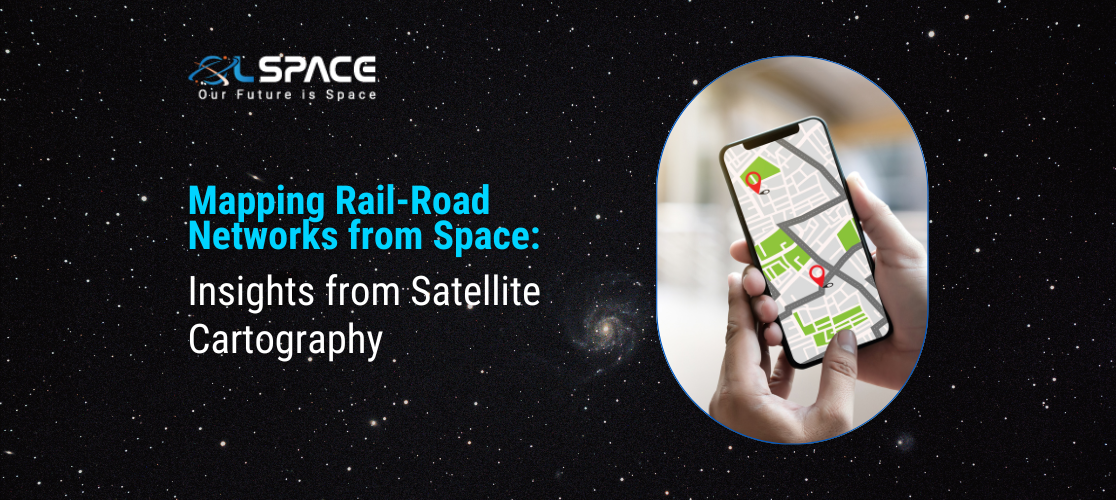17 November 2023
Mapping Rail-Road Networks from Space: Insights from Satellite Cartography

Satellite cartography has emerged as a powerful tool for mapping and monitoring rail-road networks from space. The ability to capture high-resolution images and data from satellites provides valuable insights for infrastructure planning, maintenance, and transportation management. In this blog, we will explore how satellite cartography contributes to mapping rail-road networks and the insights it offers for optimising transportation systems.
Satellite Cartography for Rail-Road Mapping
Satellite cartography involves the use of Earth observation satellites to collect geospatial data, including high-resolution imagery and terrain information. This technology has several applications in mapping and monitoring rail-road networks:1. Network Planning and Design: Satellite imagery provides a comprehensive view of the landscape, allowing planners to assess terrain, identify potential routes, and plan the layout of rail and road networks efficiently.
2. Infrastructure Monitoring: Regular satellite monitoring enables the assessment of infrastructure conditions, including rail tracks, bridges, and roads. This helps in identifying areas requiring maintenance or upgrades.
3. Traffic Flow Analysis: Satellite data can be used to analyse traffic patterns on roads and rail tracks. This information is valuable for optimising transportation routes, managing congestion, and improving overall traffic flow.
4. Environmental Impact Assessment: Satellite imagery aids in assessing the environmental impact of rail-road projects, including changes in land use, deforestation, and habitat disruption. This information is essential for sustainable development.
5. Disaster Response and Recovery: In the event of natural disasters or accidents, satellite imagery provides real-time information on the extent of damage to rail-road infrastructure. This aids in planning and executing effective disaster response and recovery efforts.
Insights from Satellite Cartography in Rail-Road Mapping
1. Terrain Analysis: Satellite cartography allows for detailed terrain analysis, helping planners understand the topography of an area. This is crucial for designing rail and road routes that minimise gradients, curves, and other challenges.
2. Vegetation Monitoring: Monitoring vegetation along rail-road corridors is essential for maintaining clear sightlines, preventing obstructions, and identifying areas prone to landslides or erosion.
3. Land Use Changes: Satellite imagery provides insights into changes in land use patterns along rail-road networks. This information is valuable for anticipating urban development, agricultural expansion, or other changes that may impact transportation infrastructure.
4. Track and Road Condition Monitoring: High-resolution satellite imagery enables the monitoring of rail tracks and road conditions. Identifying issues such as track misalignment, wear and tear, or potholes helps in prioritising maintenance activities.
5. Network Connectivity: Satellite cartography aids in assessing the connectivity and accessibility of rail-road networks. This is critical for evaluating the efficiency of transportation systems and identifying areas that require additional connectivity.
6. Traffic Density and Congestion: Analysing satellite data allows for the estimation of traffic density and congestion on roads and rail tracks. This information is valuable for optimising transportation routes and schedules.
7. Asset Management: Satellite imagery assists in inventorying and managing transportation assets, including bridges, tunnels, and road structures. Regular monitoring helps ensure the structural integrity of these assets.
Technological Advancements and Future Trends
1. RapidEye Monitoring: High-resolution satellite constellations like RapidEye provide frequent revisits and detailed imagery, enhancing the ability to monitor changes in rail-road networks.
2. Synthetic Aperture Radar (SAR): SAR technology on satellites allows for all-weather monitoring, making it possible to capture images even during cloudy or rainy conditions.
3. Machine Learning and Image Analysis: The integration of machine learning algorithms and image analysis techniques improves the automation of data extraction from satellite imagery, allowing for more efficient mapping and monitoring.
4. Real-Time Monitoring: Advances in satellite technology enable real-time monitoring of rail-road networks, providing up-to-date information for decision-making and emergency response.
Conclusion
Satellite cartography plays a pivotal role in mapping and monitoring rail-road networks from space, offering valuable insights for planning, maintenance, and transportation management. As technology continues to advance, the integration of satellite imagery, data analytics, and artificial intelligence will further enhance the capabilities of satellite cartography, contributing to the optimisation and sustainability of transportation systems around the world.
Join our community and never miss an update! Subscribe to our newsletter and blog to stay up-to-date on the latest trends, tips, and insights in your area of interest. Don’t miss out on exclusive content, promotions, and special offers. Sign up now and be a part of our growing community!
